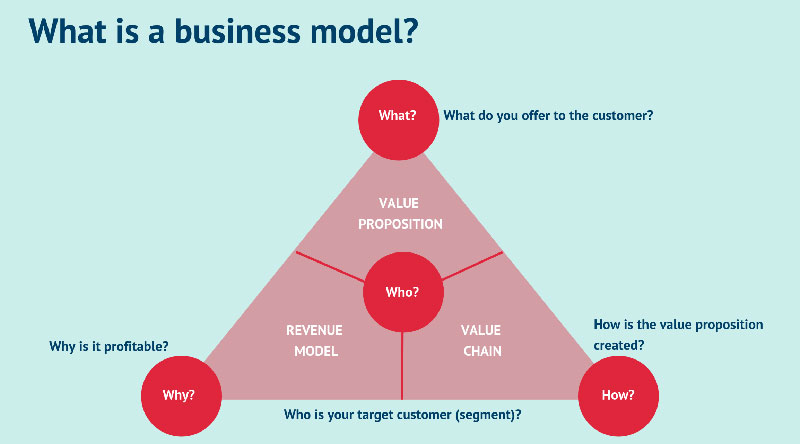Imagine navigating rough seas, where every wave is a disruptive market force, and your boat—a traditional business model—can hardly catch the wind. Business model innovation stands as the lighthouse, guiding ventures towards uncharted, lucrative waters. We live in an era where adapting and reinventing one’s business framework is not a luxury—it’s survival.
Here, creativity intersects with strategic tact. Exploring value proposition design and leveraging digital transformation has become the cornerstone for contemporary success.
This article unravels the intricate tapestry woven by inventive revenue streams optimization and scalable business models; it’s an artifact replete with knowledge for those embarked on the voyage of entrepreneurial strategy.
By the final punctuation mark, anticipate enlightenment on aligning your enterprise with the lean startup methodology and innovative pricing strategies—insights potent enough to thrust your venture into future relevancy.
From blue ocean strategy to sustainable business practices, each section is crafted to arm you with the prowess to not just exist but excel in today’s tumultuous business epoch.
What is Business Model Innovation?

A business model is a representation of how a business brings value. It shows the entire process from start to finish.
A business model is used to show how a firm transforms resources in the form of technology and converts them through customers and markets. The idea behind it is to connect resources that can bring the potential realization of economic value.
What it also includes is the customer segments that are being handled. This relates to how the company uses its resources and how it sells its offerings by creating value to the end consumer.
Consider the business model innovation as a kind of story that explains how an entire organization is functioning. The most common models usually go for topics like understanding the end customer, what the customer prefers, how to generate money, and many more. Basically, it is the underlying economic logic that explains how value is being generated for a certain cost.
As you can see, there are different ways to define a business model. Some well-known principles go behind each one, but most of the time they will include:
- Answers to strategy questions
- Defining the target market and how is the business going to reach them
- What is the company mission
- The values that are being promoted and the benefits added
- What makes the company different from the competition
The beginning of business model innovation
Over the last five decades, the lifespan of a business model has gone from 14 years to five. This is why business model innovation is essential to organize the details around your idea.
The business model innovation shows how a company is delivering value to its customers. It does not matter if we are talking about the development of a new revenue stream or another distribution channel.
Business model innovation is a fast process where the main goal is continued learning. The easiest way to start is by analyzing your customer’s point of view. This will help you understand what is important to them and how you can improve what the business is doing. However, simply having an idea is not enough. You will also need to understand consumer behaviors, test prototypes, and update the entire concept.
So, why should you consider an innovative business model? Well, at the core of it, the main idea is to bring a change. A change that cannot be seen so fast. Most companies that go for business model innovation reach success, only after this change gets detected. This is why it is very hard to copy it.
To understand how innovative business models work, just think about how the value chain can be redesigned. The insight is to focus on what can help you scale your business. Here are some tips to consider:
- Solutions to design a better value chain
- Improving the existing cost structure
- Distribution channel that can accelerate growth
- Structure of the company and how is it this helping the growth
Technological Innovation vs Business Model innovation

When you are at the start of a new business, there are a few ways to ensure that it will be sustainable. Discovering differences between business and technological innovations can help you get a clearer vision for your start-up. This will help you be more efficient, and in the end, it will lead to better decisions that are being taken in the long-term.
Compared with other types of innovation, the changes that are done to the business model need to be clear. We want them to be aligned with how the business functions. So, business model innovation is going to be seen as radical a lot of the time.
When we speak about innovations, they usually are incremental. However, technological innovations are different from business innovations. This is because they happen in special centers that do not limit just to a business context.
An example of companies that did great due to technological innovation is IBM, which was the first company to produce computers for consumers and businesses. While they are not a leader in the computer market, they still have some other dominant positions in different markets.
Lotus 1-2-3 was the company that created the first spreadsheet program. They did lose to Microsoft Excel, but oddly enough, it was not because it was a better choice. The reason behind their loss was that Microsoft offered a greater value through innovation and had Microsoft Excel preloaded on all the PCs that were sold.
FAQs about business model innovation
Why Is Business Model Innovation Important Today?
We’re sailing in a storm of perpetual change. In such swells, it keeps companies buoyant and ahead. It leverages digital transformation and scalable business models, stepping stones crucial for survival and relevance amidst aggressive competition and ever-evolving customer desires.
How Does Business Model Innovation Differ From Simple Product Innovation?
It’s broader, reaching beyond new features or gadgets. It’s about altering the essence, the revenue streams, markets—even how customers perceive value. Disruptive technology may catalyze product innovation, but rethinking your business ecosystem itself… that’s the true north of business model innovation.
Can You Give Examples of Successful Business Model Innovation?
Airbnb spun the hospitality industry on its head with its shared economy models, while Spotify’s subscription-based service danced around conventional music purchasing models. Each rewrote the rules, carving out markets where none existed, leveraging platform-based business models and innovative pricing strategies. Brick by brick, they rebuilt their industry landscapes.
What Are the Risks of Business Model Innovation?
Some gambles don’t pay off; not every voyager finds land. Risks include misreading market signals, overestimating the customer lifetime value, or underestimating resistance to change. It’s a tightrope walk where missteps can lead to falls. Still, the most significant peril lies in stagnation, the antithesis of innovation management.
How Does One Start the Process of Business Model Innovation?
Begin with a canvas—your business model canvas, that is. It’s a blueprint where you’ll chart competitive advantage, question customer segmentation, and monetization strategies. Consider it a mission map, highlighting areas to adapt or reinvent throughout your value network analysis.
What Role Does Technology Play in Business Model Innovation?
Technology is both the brush and the paint. It enables and accelerates change—think circular economy models powered by tech. From network effects in social media to analytics that deliver real-time insights, technology is the enabler of modern-day venture development.
How Do You Measure the Success of Business Model Innovation?
Success often spells itself in financial health, growth hacking techniques that work, or a customer base expanding like the horizon. Yet, true measures stretch into sustainable business practices, long-term customer engagement, and your brand’s resonating echo within your market niche. The precise value proposition design can be gauged by its marketplace performance.
Can Large, Established Companies Successfully Innovate Their Business Model?
Absolutely. Consider the phoenix; size doesn’t limit rebirth. Giants like Microsoft embraced cloud services, scaling new heights. It requires collaborative innovation, a hefty dose of courage, and a willingness to deep-dive into agile business experimentation. Tradition and size are but ingredients, not outcomes.
How Does Business Model Innovation Impact Competition?
It’s a strategic ripple—start from within, and impact the whole pond. Innovate, and you force competitors to navigate your wake. They must adapt or risk being left behind. You set the course, dictate the pace, have them chase your strategic business planning. It’s not just moving chess pieces—it’s redesigning the board.
What role do customer feedback and market research play in business model innovation?
Consumer feedback and market research are essential parts of developing new business ideas and models because they offer insightful information about customer demands, preferences, and behaviors. Customers should be routinely surveyed for input, and businesses should use this data to direct their innovation efforts.
Conclusion
In essence, we’ve unraveled the tightly wound spool of business model innovation, layer by layer. Venturing beyond familiar shores, we’ve discovered its potential to redefine the enduring competitive advantage of a brand. What emerges from the fog is a beacon of strategic business planning that swears by adaptability, one that dwells in innovative pricing strategies and lives through customer segmentation.
- It molds revenue stream optimization with an artist’s precision.
- It answers the call for a lean startup methodology, pushing boundaries, and imagining new realms.
- It guides through the shift in value proposition design, charting courses unknown.
And here we stand, at the juncture of reflection and action. Moving forward means to innovate, to embrace digital transformation, and to rekindle the spirit of entrepreneurial strategy. Cling to this knowledge as a lifeline; let the insights be your navigational stars as you steer your enterprise towards sustainable business practices and continual growth.
If you enjoyed reading this article on business model innovation, you should check out this one about Steve Jobs’s leadership style.
We also wrote about a few related subjects like business model vs business plan, accelerator vs incubator, startup funding stages, how to value a startup, IPO process, IPO lockup period, risk assessment matrix and business process modelling.
- What Is a War Room and How to Use it in Project Management - April 23, 2024
- Business model innovation: What it is and why it matters - April 20, 2024
- What Is A Risk Assessment Matrix And How To Use It - April 8, 2024









